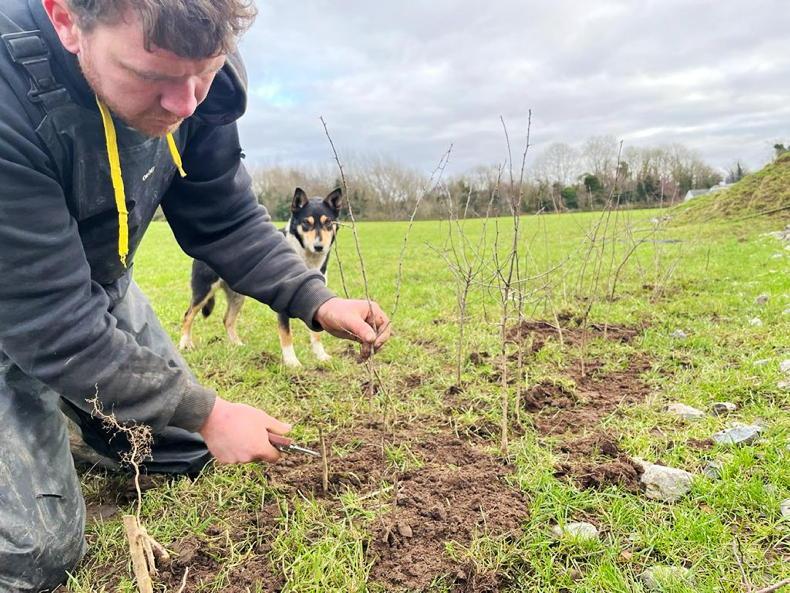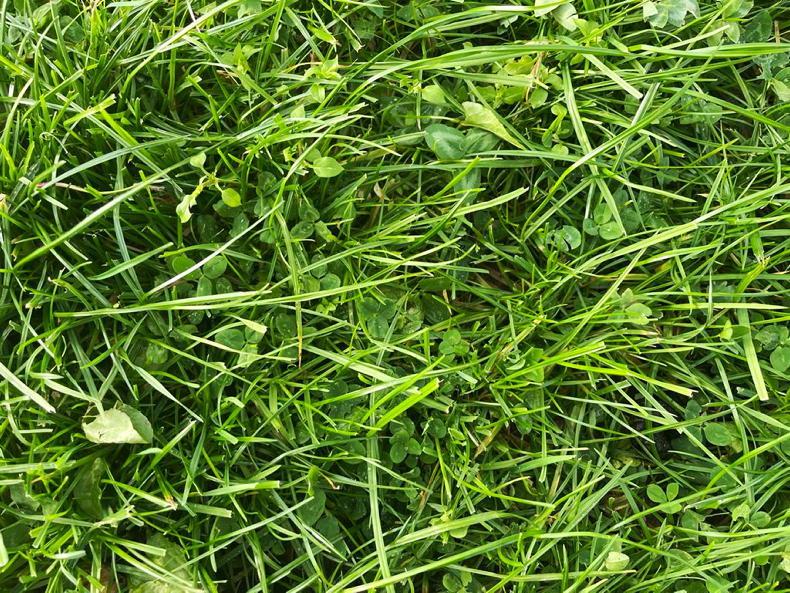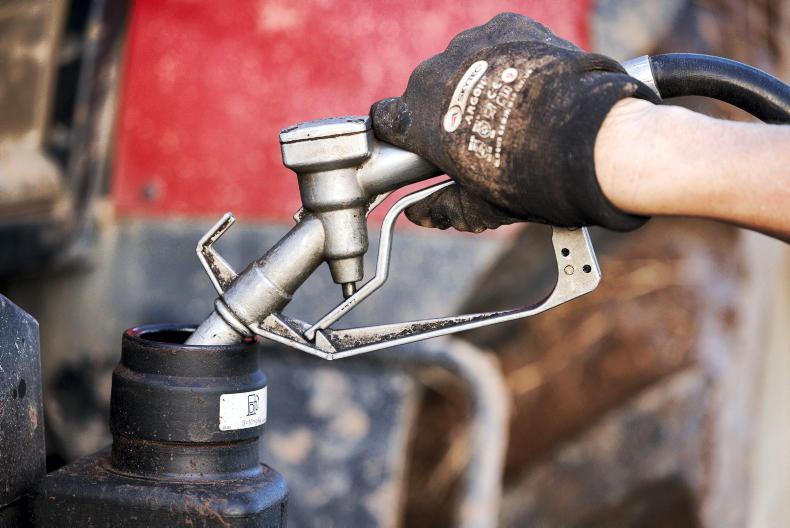It will be a busy few months for Tullamore Farm manager Shaun Diver, with 90 cows due to calve and 250 ewes ready to lamb on the farm. Two heifers had calved just before the Irish Farmers Journal team visited last week. We also finished planting a whitethorn hedge on the farm, which will eventually provide a stock proof fence between one of the paddocks and the farm yard.
Fertiliser planning
Stocked at 2.3 LU/ha, the farm is in derogation, so it is important that a nutrient management plan is followed to ensure nutrients are managed effectively and in a sustainable manner. Shaun details the plan for fertiliser for the year ahead.
Getting some slurry out is first on the list and 10 loads have already been spread at a rate of 2,300 gallons/ac to take some pressure off the tanks.
Shaun is waiting on soil temperatures to improve so growth can kick off once the rest of the slurry goes out. It’s an early farm in terms of growth and Shaun is expecting to see some grass growth beginning at the start of February on the outfarm at Cloona if the weather conditions are right.
Approximately 25 units of urea per acre will be spread across this area to help kick-start this growth.
Soil samples have been taken recently on the farm as part of the Footprint Farmers Programme, so Shaun will be in a better position to decide where the slurry will be going once those results are back.

Farm manager Shaun Diver pruning the bare rooted Whitethorn whips.
So far, the plan is that silage ground will take priority for slurry and farmyard manure, as these paddocks tend to be lower for phosphorous (P) and potassium (K) due to higher offtakes.
For the grazing ground, the first fertiliser to be spread will be early urea. There’s about 5t left over from last year, which should see the farm through the first round of fertiliser spreading on the dry part of the farm.
At the moment, the grass cover across the farm is lower than expected, due to the wet winter.
Cover is currently about 400kg DM/ha across wetter areas of the farm. However, these areas were grazed off by sheep over the winter and drier parts of the farm have more grass, which suits Shaun.
The aim is to drive growth to 600kg DM/ha before stock is turned out.
Saving on N
The plan is for nitrogen (N) to be cut on the multi-species and red clover swards on the farm. The aim is for these low-N swards to allow Shaun to cut chemical N use by a further 10% across the farm this year. This follows a cut of 15% last year, which was a substantial saving on costs in a year where fertiliser prices were high.
It’s hoped to get N use down to 130/140kg N/ha, which is the lowest that the farm can aim for given its stocking rate of 2.3 LU/ha.
If needed, Shaun is considering putting in more multi-species swards or clover to ensure the farm reaches this target.
P and K
P and K levels are low on the farm and the focus has been on building P and K levels the last few years. However, as K levels are low in slurry because K levels are low in the grass, this area will also require bag fertiliser such as muriate of potash (MOP). The soil samples, which have just been taken, will show where the farm is this year in terms of building up these levels, so that Shaun can plan accordingly.
There is some work needed to improve P and K values on the soils across the farm. The silage ground will be a bit lower, so slurry and farmyard manure (FYM) will be targeted there.
pH across the farm
The farm is naturally quite good in terms of pH levels, even a bit higher than is recommended for grassland swards in places, with the pH ranging from 6.5 to 7.3 on Cloona, the outfarm. These high-pH paddocks tend to be in the drier half of the farm.
Cutting the fertiliser bill
Last year, the fertiliser bill on the farm doubled to €33,000 from €16,500. For drystock, a bill like this can have a detrimental effect on farm profit, where margins are already tight.
The aim is to cut this bill by at least 10% this year, and this is where clover and multi-species swards will have an integral role.

Low N swards such as the red clover sward on the farm will have an important role to play in cutting back on N use and decreasing the fertiliser bill.
Traditionally, N would be spread in early spring on Tullamore Farm, even on clover swards, however last year N was cut off from certain parts of the farm from May onwards.
These areas received no N until the back end of the year, when it would have gotten another half bag again.
Cutting N use on these areas resulted in Shaun saving a bag and a half to two bags an acre on the clover-rich swards, which was a huge saving, with urea priced at over €900/t.
Ten loads of slurry are out to-date at a rate of 2,300 gallons/ac. This, along with 25 units of urea/acre will help kickstart growth across the farm.Silage ground will take priority for slurry and FYM due to lower K levels as a result of higher offtakes.The aim is to cut the fertiliser bill by 10% this year. The high clover and multi-species swards will have an integral role here.N was cut from some areas of the farm from May last year, which saved up to two bags or urea/acre.
It will be a busy few months for Tullamore Farm manager Shaun Diver, with 90 cows due to calve and 250 ewes ready to lamb on the farm. Two heifers had calved just before the Irish Farmers Journal team visited last week. We also finished planting a whitethorn hedge on the farm, which will eventually provide a stock proof fence between one of the paddocks and the farm yard.
Fertiliser planning
Stocked at 2.3 LU/ha, the farm is in derogation, so it is important that a nutrient management plan is followed to ensure nutrients are managed effectively and in a sustainable manner. Shaun details the plan for fertiliser for the year ahead.
Getting some slurry out is first on the list and 10 loads have already been spread at a rate of 2,300 gallons/ac to take some pressure off the tanks.
Shaun is waiting on soil temperatures to improve so growth can kick off once the rest of the slurry goes out. It’s an early farm in terms of growth and Shaun is expecting to see some grass growth beginning at the start of February on the outfarm at Cloona if the weather conditions are right.
Approximately 25 units of urea per acre will be spread across this area to help kick-start this growth.
Soil samples have been taken recently on the farm as part of the Footprint Farmers Programme, so Shaun will be in a better position to decide where the slurry will be going once those results are back.

Farm manager Shaun Diver pruning the bare rooted Whitethorn whips.
So far, the plan is that silage ground will take priority for slurry and farmyard manure, as these paddocks tend to be lower for phosphorous (P) and potassium (K) due to higher offtakes.
For the grazing ground, the first fertiliser to be spread will be early urea. There’s about 5t left over from last year, which should see the farm through the first round of fertiliser spreading on the dry part of the farm.
At the moment, the grass cover across the farm is lower than expected, due to the wet winter.
Cover is currently about 400kg DM/ha across wetter areas of the farm. However, these areas were grazed off by sheep over the winter and drier parts of the farm have more grass, which suits Shaun.
The aim is to drive growth to 600kg DM/ha before stock is turned out.
Saving on N
The plan is for nitrogen (N) to be cut on the multi-species and red clover swards on the farm. The aim is for these low-N swards to allow Shaun to cut chemical N use by a further 10% across the farm this year. This follows a cut of 15% last year, which was a substantial saving on costs in a year where fertiliser prices were high.
It’s hoped to get N use down to 130/140kg N/ha, which is the lowest that the farm can aim for given its stocking rate of 2.3 LU/ha.
If needed, Shaun is considering putting in more multi-species swards or clover to ensure the farm reaches this target.
P and K
P and K levels are low on the farm and the focus has been on building P and K levels the last few years. However, as K levels are low in slurry because K levels are low in the grass, this area will also require bag fertiliser such as muriate of potash (MOP). The soil samples, which have just been taken, will show where the farm is this year in terms of building up these levels, so that Shaun can plan accordingly.
There is some work needed to improve P and K values on the soils across the farm. The silage ground will be a bit lower, so slurry and farmyard manure (FYM) will be targeted there.
pH across the farm
The farm is naturally quite good in terms of pH levels, even a bit higher than is recommended for grassland swards in places, with the pH ranging from 6.5 to 7.3 on Cloona, the outfarm. These high-pH paddocks tend to be in the drier half of the farm.
Cutting the fertiliser bill
Last year, the fertiliser bill on the farm doubled to €33,000 from €16,500. For drystock, a bill like this can have a detrimental effect on farm profit, where margins are already tight.
The aim is to cut this bill by at least 10% this year, and this is where clover and multi-species swards will have an integral role.

Low N swards such as the red clover sward on the farm will have an important role to play in cutting back on N use and decreasing the fertiliser bill.
Traditionally, N would be spread in early spring on Tullamore Farm, even on clover swards, however last year N was cut off from certain parts of the farm from May onwards.
These areas received no N until the back end of the year, when it would have gotten another half bag again.
Cutting N use on these areas resulted in Shaun saving a bag and a half to two bags an acre on the clover-rich swards, which was a huge saving, with urea priced at over €900/t.
Ten loads of slurry are out to-date at a rate of 2,300 gallons/ac. This, along with 25 units of urea/acre will help kickstart growth across the farm.Silage ground will take priority for slurry and FYM due to lower K levels as a result of higher offtakes.The aim is to cut the fertiliser bill by 10% this year. The high clover and multi-species swards will have an integral role here.N was cut from some areas of the farm from May last year, which saved up to two bags or urea/acre. 











SHARING OPTIONS